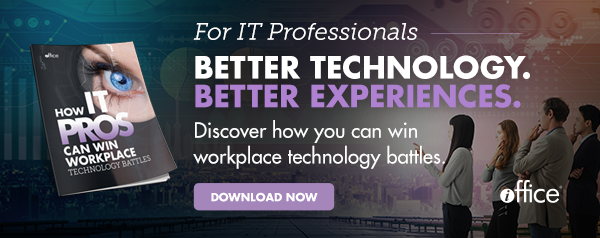3 Digital Workplace Disruptors IT Managers Need To Confront Now


It’s a rule as universal as Murphy’s Law: Just when you think you’ve got it all figured out, something is bound to change.
This is as true in everyday life as it is within the workplace. Just as your organization is gaining momentum implementing a digital workplace, new technology and new trends enter the picture to shake things up. As an IT professional, you play an important part in ensuring you have all the right technology in place to empower your workforce and that it’s working properly.
If you want to build a digital workplace that’s agile and able to keep up with changes, here are four disruptors you need to keep in mind.
1. A Move Toward User-Friendly Digital Workplace Technology
A digital workplace cannot exist without the right technology. It’s as simple as that. However, the defining characteristic of the “right” technology is not just how robust or powerful it is. It’s whether its user interface (UI) is designed in a way that encourages your workforce to actually adopt it. Solutions with high adoption rates have a UI that operates in a way that’s similar to the apps they use at home and is optimized for any device.
In a survey conducted by human resource solutions provider Ultimate Software, 92 percent of respondents claimed their job satisfaction is impacted by whether or not they have the right technology to complete projects efficiently. And according to research from Sungard Availability Services, 36 percent of employees report they would leave their current position to go work for a more “digitally progressive” company. That means ensuring employees have the tools they need to be productive wherever they are, whether they are on their desktop or moving between meetings and checking their smartphone.
2. An Increase in Cybersecurity Threats
According to the 2017 Data Breach Year-End Review, an annual report by the Identity Theft Resource Center® (ITRC) and CyberScout®, American businesses saw a nearly 45 percent year-over-year increase in cybersecurity breaches between 2016 and 2017. And unless IT managers want to see their company on the list of those who experienced a breach, they need to take the appropriate measures to protect their data.
One of the most effective ways to decrease cybersecurity threats is to invest in Software-as-a-Service (SaaS) solutions. SaaS platforms offer many advantages to enterprises. In addition to being less expensive and easier to update than in-house or hosted solutions, SaaS platforms are less susceptible to cybersecurity attacks.
Unlike an in-house or hosted platform, which is only used by your individual organization, a SaaS solution is shared among multiple companies. Not only can you perform your own penetration tests and vulnerability evaluations, but the other organizations can also run their own assessments. Every company is working together to ensure the database is secure. Additionally, because updates to SaaS solutions are deployed automatically, you can be confident the provider has addressed known vulnerabilities.
3. A Greater Emphasis on Collaboration and Integration
Your workforce and your workplace technology have one important thing in common: neither can reach maximum productivity and efficiency if they don’t work together. It’s the employer’s responsibility to make sure they can.
Collaboration is what fuels an organization. In fact, a recent study found organizations that supported a collaborative environment were five times more likely to have a high-performing workforce. However, a major challenge today’s companies face is being able to support collaboration between the on-site and remote workforce.
The number of employees working remotely grows every year. And while offering remote work options can offer an organization abundant benefits – increased productivity, improved retention and higher employee satisfaction, for example – it does make collaboration more difficult. But by offering every employee access to the same technology and by ensuring that technology can give the workforce what it needs to be productive, you can break down the silos that inhibit success.
A Single Solution For The Digital Workplace
Managing information and resources with cloud-based platforms can resolve nearly every problem discussed above. Cloud technologies are designed to be user-friendly, built for flexibility and better equipped to protect companies from data breaches.
However, just implementing cloud-based technology in the workplace isn’t enough. The technology also needs to meet employees where they are and be accessible through any device they happen to be using.
Fortunately, an organization can kill all of these birds with one stone with an employee experience solution like iOFFICE Hummingbird. iOFFICE Hummingbird acts as a single hub for the multiple technologies that make collaboration in a digital workplace possible. It integrates tools such as room reservations, wayfinding and resource scheduling into a single user-friendly, SaaS-based platform. Hummingbird is what every IT manager needs in order to build a powerful digital workplace. Learn more about how Hummingbird makes an IT professional’s life easier.
